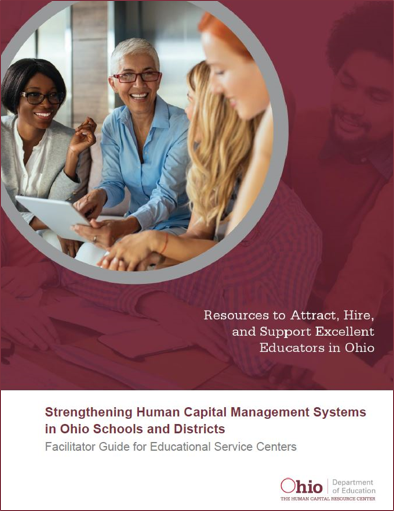Find Your Entry Point
This free self-assessment is designed to help professionals in educational organizations identify strengths and growth areas in their human capital management system (HCMS).
The assessment includes 30 statements that describe best practices in human capital management. These statements are aligned with the Professional Human Capital Leaders in Education (pHCLE) Standards. The pHCLE standards were developed by a national committee of human capital leaders in PK–12 education institutions. They define the core knowledge and skills needed to improve talent practices in education.
Take the assessment today to know where your organization currently stands, and make a plan for how to close any gaps. The quick start guide can help you use the tool and take action based on your results
Why focus on human capital management in Ohio Education?
Employees are your single greatest asset. Schools and districts that prioritize finding the right people, growing and supporting them, rewarding excellence, and continuously improving are better equipped to meet the needs of the organization, employees, and students.
An effective human capital management system (HCMS) helps schools and districts:
Ensure students are served by quality educators and staff that are engaged, supported, and actively growing in their profession.
Create a better learning environment for students by reducing shortages, increasing retention, and building supportive partnerships.
Build a diverse cadre of educators, staff, and building leaders to support students and address equity gaps.
Increase efficiencies by reducing issues related to staff discipline and absenteeism, legal fees, and grievances.
WHO are human capital leaders?
Human capital leaders in school systems can be found across the organization, in departments other than human resources. They may include any of these individuals who can benefit from the Human Capital Resource Center:
District and building leaders
Teacher leaders, instructional coaches, and mentors
Public, private, and charter school executives and department directors
Other education organization employees (at Educational Service Centers and other regional supports)
Educator preparation faculty at colleges and universities
Anyone else who has a stake in improving the human capital of school systems
Making smart human capital decisions in school systems requires a broad-based team effort. The responsibility extends beyond the traditional human resource group. It requires meaningful partnerships across Ohio and within local districts and schools.
Maximizing HCRC Resources
Resources on the HCRC are meant to be freely used, adapted, and shared to drive human capital improvements in education. The HCRC serves as a hub for design guides, process steps, templates, tip sheets, inspiring examples, and more.
The HCRC At-a-Glance document provides a quick view of the HCRC resources and ideas for their use. You can use this resource with stakeholders, such as board members and building administrators, to engage in conversations about how the HCRC can support your human capital priorities.
If you are new to human capital management, below are a few resources to get you started.
Supporting Schools and Districts with HCRC Resources
If you are a regional education service provider or work with schools and districts on human capital, the HCRC developed a facilitation guide to help you leverage HCRC resources in your work.




